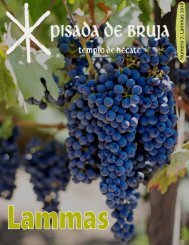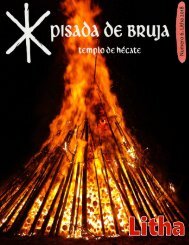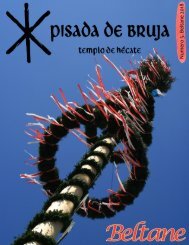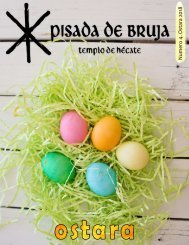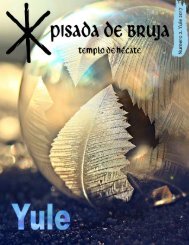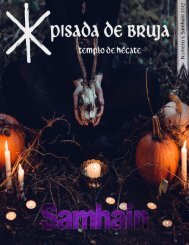Create successful ePaper yourself
Turn your PDF publications into a flip-book with our unique Google optimized e-Paper software.
epresentación <strong>de</strong> la koré<br />
fósforos, como Perséfone,<br />
Selene y Artemis, mostrando<br />
atributos que provienen<br />
<strong>de</strong>l inframundo, la luna y la<br />
tierra. West duda <strong>de</strong> esta<br />
teoría, ya que se basaría en<br />
un sincretismo tardío que<br />
no sería suficiente justificación<br />
para un motivo tan<br />
importante como la triple<br />
imagen.<br />
Otra interesante teoría<br />
enuncia que la forma triple<br />
podría <strong>de</strong>rivar <strong>de</strong> la figura<br />
<strong>de</strong> Hécate con dos perros,<br />
uno a cada lado. En este<br />
sentido, existe un lekythos<br />
<strong>de</strong> figuras negras en el que<br />
se duda <strong>de</strong> si la figura<br />
representada podría ser<br />
Scylla o Hécate. Algunos<br />
autores, siguiendo la teoría<br />
<strong>de</strong> Semni Karouzou, opinan<br />
que se trata <strong>de</strong> Hécate<br />
<strong>de</strong>bido a dos columnas que<br />
hacen suponer que se trata<br />
<strong>de</strong> una escena <strong>de</strong>l inframundo.<br />
La imagen en<br />
cuestión se compone <strong>de</strong><br />
una forma central <strong>de</strong> mujer<br />
que parece adherida en<br />
una unidad con dos perros<br />
situados uno a cada lado.<br />
Claudina Romero Mayorga, FERNÁN<br />
DEZ URIEL, P. y RODRÍGUEZ LÓPEZ,<br />
I. (eds.): Iconografía y sociedad<br />
en el Mediterráneo antiguo,<br />
Homenaje a la profesora Pilar<br />
González Serrano, Signífer libros<br />
imágenes:<br />
Crátera <strong>de</strong> volutas <strong>de</strong> figuras<br />
rojas, siglo IV aC.<br />
theoi.com/Gallery/T16.2.html.<br />
Relieve <strong>de</strong> Hécate triple<br />
encontrado en Aegina,<br />
probablemente <strong>de</strong>l siglo IV aC.,<br />
The cults of the Greek states<br />
vol.II, Lewis Richard Farnell,<br />
Oxford University, 1896.<br />
Lekythos ateniense <strong>de</strong> figuras<br />
negras, Museo Arqueológico<br />
Nacional <strong>de</strong> Grecia,<br />
https://www.iconiclimc.ch/<br />
visitors/treeshow.php?<br />
source=139&image_id=4794<br />
&term=Hekate.<br />
Buxa Oest<br />
bibliografía:<br />
The cults of the Greek states<br />
vol.II, Lewis Richard Farnell,<br />
Oxford University, 1896<br />
Some cults of Greek God<strong>de</strong>sses and<br />
female daemons of Oriental<br />
origin, Reid West, David, Universidad<br />
<strong>de</strong> Glasgow, 1990, p. 317.<br />
Aproximación a la iconografía <strong>de</strong><br />
Hécate: magia, superstición y<br />
muerte en la sociedad romana,





